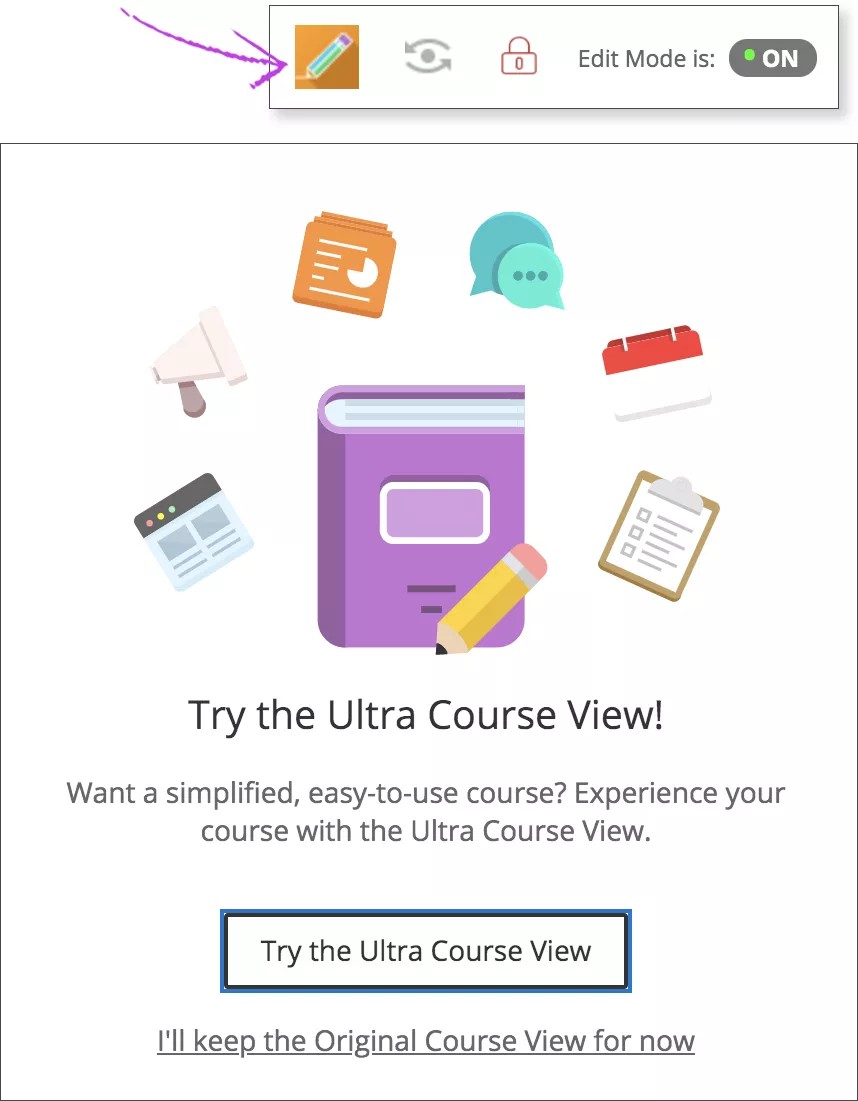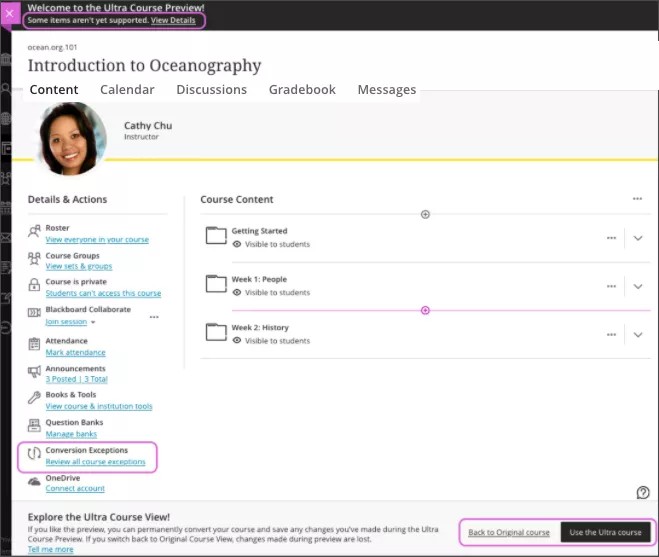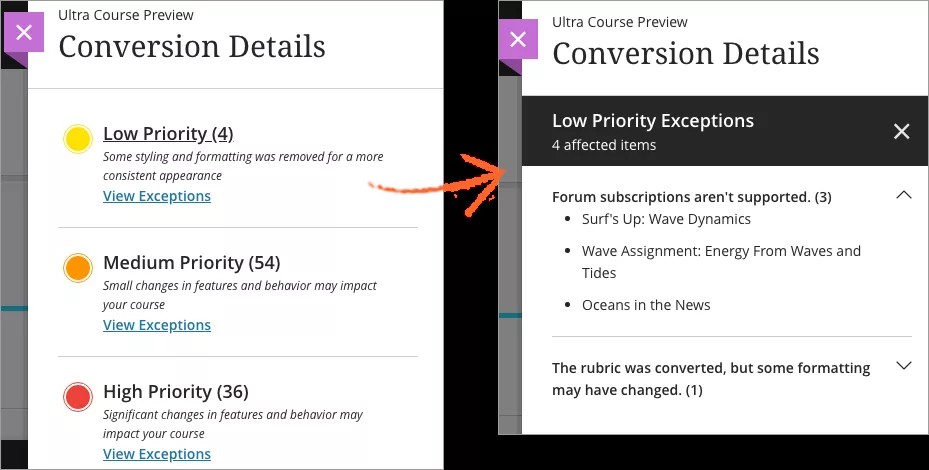Nämä tiedot koskevat vain Ultra-käyttöliittymää.
When your institution enables the Ultra experience, you may be allowed to have a mix of courses in the Ultra Course View and the Original Course View. Choose the course view that works best for each of your courses. Both course views appear seamlessly in your course list.
You can fully explore your Original course in the Ultra preview before you switch to the Ultra Course View. You can also review a list of features and functions that change or won't carry forward if you convert.
On this page, learn about:
Video: Ultra Course Preview
Watch a video about Ultra Course Preview
The following narrated video provides a visual and auditory representation of some of the information included on this page. For a detailed description of what is portrayed in the video, open the video on YouTube, navigate to More actions, and select Open transcript.
Video: Ultra Course Preview explains how to use Ultra Course Preview to view how your Original Course would look in the Ultra Course View.
How the preview works
You can only preview courses that aren't currently open to students. You can make your course private while you try the Ultra preview. On the Courses page, select Make course private from the course's menu.
If you attempt to switch your course from Private to Open during the preview, you'll be warned that you won't be able to switch back to the Original Course View. The course is converted to Ultra Course View automatically.
The preview is just that—a preview. You don't have to make a permanent change to your course.
- If you approve of the Ultra Course View, you can permanently convert your course.
- If you aren't ready to make the switch, you can return to the Original Course View. But, any changes you made to your course in the preview mode are lost if you switch back to the Original Course View. Use the preview to explore rather than build.
Can students see the preview?
When your course is in preview mode, only instructors and administrators can view it.
After you open your course to students, students see the course view you chose. You can only open a course to students if it's in the Original Course View or permanently converted to the Ultra Course View.
If you make a course available in the preview mode, students can access the course and submit assignments. This can cause data to be lost if you switch back to Original later.
Begin the preview
After your institution enables the Ultra experience, you can start the Ultra preview at any time from your Original Course View.
Select the Experience the new Learn button in the top-right corner of the page. In the pop-up window, start the conversion to the Ultra Course View.
If you don’t see the Experience the new Learn button, your Blackboard Administrator may need to set your course experience from the Original Course View to Instructor Choice. You also need to make sure that your course is not open (unavailable) to students.
You'll receive an email notification when your course is ready. From the Courses page, open your course and review how your content looks in the Ultra Course View.
Explore the preview
In the Ultra Course preview, you can see exactly how your content will look if you decide to permanently switch to the Ultra Course View.
Select the View Details link in the banner or the Course Exceptions link in the Details & Information area to view how many items won't carry forward in the Ultra Course View. These items are known as exceptions.
In the Conversion Details panel, select a priority group to view the specifics so you can make the best decision for your course. At this time, some features aren't yet included in the Ultra Course View such as surveys, Self and Peer Assessments, wikis, and blogs.
Understanding exception priorities
Permanently converting your course to the Ultra Course View is a big step. For some instructors, the Ultra Course View is a big shift from the Original Course View. Other instructors may welcome the more modern interface and streamlined features. To help you better understand how your course environment will change, the system groups exceptions into three priority groups, based on the potential impact.
- Low Priority exceptions include course appearance changes, formatting changes, or slight feature limitations.
- Medium Priority exceptions include feature behavior changes and formatting and submission removal.
- High Priority exceptions include unsupported features and grade data removal.
Select View Exceptions under a priority heading to learn more. All exceptions in that category appear in the panel. To see how the exception affects parts of your course, select an exception. The list of affected content appears so you can understand the specific changes.
Remember, you're in preview mode. You haven't committed to a permanent conversion of your course yet.
Any changes you make to your course while in the Ultra Course View preview won't be saved if you exit the preview and choose to continue in the Original Course View. If you choose to permanently convert your course to Ultra, the changes you made during the preview are saved.
Content types that will convert
As features and functions continue to roll out for the Ultra Course View, the supported list will expand.
- Announcements
- Assignments
- Blank Pages
- Content Areas
- Content Folders
- Content Packages (SCORM)
- Course Banner
- Course Menu Blank Pages
- Course Menu Web Links
- Discussion Forums and Threads
- Files
- Flickr Mashups
- Goals
- Grade Center
- Categories
- Grade Schemas
- Group Sets
- Items
- Journals (note that journals that aren't linked within a content area are not converted)
- Learning Modules
- Lesson Plans
- Multimedia: Audio, Image, and Video
- Rich Content Editor: Styling, Fonts, and Font Sizes
- Question Pools
- Question Sets
- Question Types
- Calculated Formula
- Calculated Numeric
- Etiher/Or
- Essay
- Fill in multiple blanks
- Fill in the blank
- Hotspot
- Matching
- Multiple Answer
- Multiple Choice
- Short Answer
- True/False
- Random Blocks
- Rubrics
- Tests
- Web Links
When converting courses, text schemas convert to a points schema. After conversion, you can create and apply an alternate schema as needed.
Content types and settings that will NOT convert
These items are removed from the course when you convert permanently to Ultra Course View:
- Achievements
- Blogs
- Contacts
- Course Links
- Course Menu Module Page
- Course Menu Tool Links
- Course Menu Course Links
- Course Menu Subheader
- Course Menu Divider
- Glossary
- Grading Color Codes
- Grading Periods
- Module Page
- Question Types
- File Response
- Jumbled Sentence
- Opinion Scale/Likert
- Ordering
- Quiz Bowl
- Self And Peer Assessments
- Smart Views
- Surveys
- Syllabus
- Total Column
- Weighted Total Column
- Wikis
- Standalone Groups
Participation and activity data are not preserved during the conversion process. Items like posts on Discussions, Assessment submissions, and grades are all removed.
Choose your course view
After you preview the Ultra Course View, you can either permanently convert the course to Ultra or stay with the Original version.
Select the course view you want in the bar at the bottom of your screen.
- Back to Original course: Your course reverts to the way it was before the preview. Remember, any changes you made to your course during the Ultra preview are lost if you go back to the Original Course View.
- Use the Ultra course: After you make the conversion permanent, you can open the course to students when you're ready.




